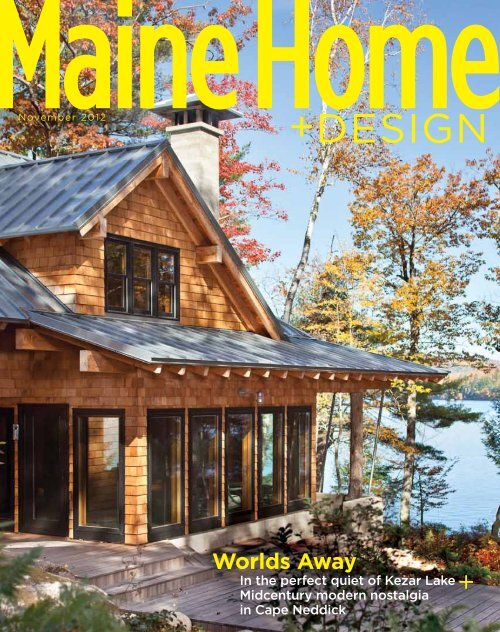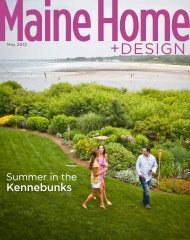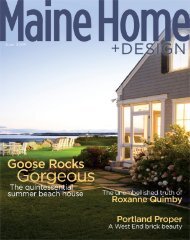You also want an ePaper? Increase the reach of your titles
YUMPU automatically turns print PDFs into web optimized ePapers that Google loves.
November 2012<br />
Worlds Away<br />
In the perfect quiet of Kezar Lake<br />
Midcentury modern nostalgia<br />
in Cape Neddick
75 Market Street<br />
Suite 203<br />
207-772-3373<br />
www.mainehomedesign.com<br />
If you choose to post this article online, please post as is without alterations,<br />
and provide a link back to Maine Home+Design. Thank you.
<strong>Lakeside</strong> <strong>Refuge</strong><br />
Adirondack camp meets European chic on Kezar Lake
y <strong>Debra</strong> <strong>Spark</strong> | Photography Irvin Serrano<br />
MH+D november 2012 49
Architect Pierre Vial says that when he first<br />
conceived of his lakeside home (opening spread)<br />
he had “the idea of a big roof that would be very<br />
protective and wide and would give the character<br />
of the house.” He imagined a place “where you<br />
would feel protected and cozy.”<br />
Vial designed his house (left) to be low in order<br />
to facilitate a view through the trees. Here, the<br />
view is from the lake up to the living room’s bay<br />
window.<br />
The galley kitchen (opposite) showcases the<br />
principal materials used in the home: Douglas fir,<br />
stainless steel, and concrete. Although a typical<br />
kitchen’s countertops are two feet deep, these<br />
countertops are three feet deep to allow more<br />
working space and ample interior storage in an<br />
otherwise a small kitchen. The birch cabinets have<br />
been painted a camp green.<br />
Forget about GPS and MapQuest.<br />
If you are going to get to the lakeside retreat of Charlotte and<br />
Pierre Vial, you are going to need old-fashioned help. To wit, the<br />
gracious couple will meet you at a marina in western Maine. They’ll<br />
guide you deep into the forest along dirt roads until you arrive at<br />
a clearing in the woods. Here, amid oak and hemlock trees, you’ll<br />
find a broad-roofed timber-frame house shingled in western red<br />
cedar. Sitting by Kezar Lake in perfect quiet, the house will seem<br />
worlds away, even from the sleepy country roads you have just<br />
left.<br />
The story of the Vial home begins with a romance. Pierre Vial,<br />
child of the French Alps, moves to Paris to fulfill his dream of becoming<br />
an architect. One day after class at the École Nationale<br />
Supérieure des Beaux-Arts, a friend invites him to a nearby cafe.<br />
There Pierre meets Charlotte, a young woman from Biddeford<br />
Pool, who has come to the city to learn French. Two years later,<br />
they marry. Flip one calendar and then another and still others to<br />
see them settle in Paris for 14 years, move to Evian for another 35,<br />
and raise three children. All the while Pierre designs private houses,<br />
office buildings, apartments, and small factories. Finally, slow the<br />
calendar pages and stop on a single year: 2005. A group of French<br />
architects arranges a tour of modern architecture in Finland. The<br />
Vials decide to go. With its lakes, forests,<br />
and red barns, Finland reminds them of<br />
Maine. In the bus, admiring the scenery,<br />
Charlotte feels inspired. She wants to build<br />
a house on a Maine lake. Why not? The children<br />
have grown up, gone to college, and<br />
settled in the States. Perhaps it’s time that<br />
she and Pierre move, too?<br />
A year later, Charlotte arrives in Maine to<br />
scout property. She knows exactly where<br />
she wants to go: a lake in the western part<br />
of the state. She knows the lake because she and Pierre visited<br />
it 30 years prior. At the time, Charlotte wanted to show Pierre a<br />
“real” lake. Until that point, he had experienced only what he calls<br />
“civilized lakes,” such as Lake Geneva. A lake in the woods was<br />
another matter. “I must admit,” he says of that long-ago visit, “I<br />
was blown away.” By late 2006, the Vials are in Maine, living in Biddeford<br />
Pool and building a second home by the lake.<br />
“My idea for the house,” Vial says, “was for a big roof that would<br />
be very protective and wide and would suggest the character of<br />
the house. It would be someplace where you would feel protected<br />
and cozy.” Thus, the ceilings are low, the rooms small. In addition<br />
to several bedrooms and baths, the house includes a sunroom,<br />
screened-in porch, galley kitchen, dining room, and steam room.<br />
The largest space is the living room, which has a substantial bay<br />
window that offers a grand view of the lake framed by birches.<br />
In a sense, the house marries what the Vials have married:<br />
Maine and France. The New England influences are evident in the<br />
camp decor and the abundant use of wood. The house features<br />
tables purchased in the Adirondacks, rustic bed frames, a potbellied<br />
stove from western Massachusetts, antique quilts, Brahms<br />
Mount blankets, and bed pillows that have been made from old<br />
raccoon coats. Roderic Blood of Rod Iron Designs in Lovell made<br />
50 november 2012 MH+D
MH+D november 2012 51
52 november 2012 MH+D<br />
Pierre Vial chose cold materials to contrast<br />
the warm, richly textured Douglas fir on<br />
the walls and ceiling of the living room. The<br />
concrete fireplace has built-in bookcases on<br />
the sides. The floor has a colored concrete<br />
finish that has been swirled into patterns.
MH+D november 2012 53
In addition to the main house, the Vials have<br />
a cabin by the water, built on the footprint<br />
of a structure that dated from the 1920s. The<br />
waterfront cabin is like the main house in<br />
miniature. The interior is part Maine camp—all<br />
the interior wood has been painted a barn<br />
brown—and part contemporary surprise, with<br />
pops of mint green furniture.
FIRST FLOOR<br />
I<br />
E<br />
SECOND FLOOR<br />
A B C D F G<br />
M<br />
H<br />
J<br />
K<br />
L<br />
Q<br />
R<br />
F F<br />
M M<br />
O<br />
N<br />
P<br />
S<br />
A<br />
B<br />
C<br />
D<br />
E<br />
F<br />
G<br />
H<br />
I<br />
J<br />
Garage<br />
Breezeway<br />
Mudroom<br />
Laundry<br />
Porch<br />
Bedrooms<br />
Hallway<br />
Kitchen<br />
Screened Porch<br />
Dining Area<br />
K<br />
L<br />
M<br />
N<br />
O<br />
P<br />
Q<br />
R<br />
S<br />
Living Room<br />
Sun Room<br />
Bathrooms<br />
Studio<br />
Master Bedroom<br />
Master Bathroom<br />
Play Room<br />
TV Room<br />
Hot Tub<br />
steel rails that look like metal twigs for an upstairs balcony. Builder<br />
Gary Crowell of Crowell Construction in Harrison painted the<br />
wood of the kitchen cabinets and the bedroom floors with the<br />
deep green paint that is so often used in Maine camps. Elsewhere,<br />
unpainted Douglas fir dominates. It is used for the interior<br />
walls and built-ins, including the custom bathroom vanities.<br />
The European influences are apparent in the decidedly contemporary<br />
fixtures, furnishings, and accent materials. Pendant<br />
and wall lights in the kitchen and dining area are of a Danish<br />
design. A glass bridge separates an upstairs office from a bedroom<br />
corridor. The living room fireplace, kitchen half-wall, bathroom<br />
shower stalls, and downstairs floor are all concrete. On the<br />
shower stalls and floors, the concrete has a skim coat of colored,<br />
marbleized concrete. For the chimney and half-wall separating<br />
the dining area and kitchen, mason Wayne Libby of Stow poured<br />
concrete into rough-board forms to produce a wood-grain finish.<br />
(“I’ve done just about everything else,” Libby laughs about the<br />
concrete chimney, “but I’ve never done anything like that.”) The<br />
steam room was laid with tiles that are reminiscent of the white<br />
tiles of the Paris Metro. “We almost wrote the name of the lake<br />
in blue tiles, as if it were a station, but we refrained,” Vial says.<br />
Of course, some details can’t quite claim a nationality, such as<br />
the stainless steel in the kitchen, which was custom fabricated by<br />
Tigpro in Portland. Pierre didn’t want to introduce too many different<br />
materials into the house, and because the appliances were<br />
already going to have some stainless steel, he decided to extend<br />
this material to the counters, backsplash, and drain board.<br />
Green design is very important to Pierre, and the house uses<br />
geothermal heat thanks to two exterior wells, a geothermal<br />
pump, and radiant in-floor coils on both the first and second<br />
floors. To make geothermal heating effective, the house had to<br />
be superinsulated. Crowell spray-foamed the wall cavities with<br />
Corbond and then added two additional inches of polystyrene<br />
foam and plywood before he finished the walls with interior paneling<br />
and drywall.<br />
The house, built on a gentle slope descending to the lake, is<br />
designed to hug the land. When you walk into the front door, you<br />
take a few steps down to reach the front corridor and then a few<br />
more steps down to reach the living room. Because the ceiling<br />
height doesn’t change, the rooms get bigger as you descend,<br />
creating real visual drama: the entire house seems to open up as<br />
you move toward the beautiful view from the living room.<br />
For the outdoors, Harry Nyberg of Lovell Logging and Tree<br />
Service in Lovell says that he tried to “heal” the site because<br />
it had been “freshly scarred” during the construction. He selectively<br />
cleared the property and created pathways lined in wood<br />
chips through the woods. He also built a footbridge over a seasonal<br />
stream and designed a rocky channel for dealing with roofwater<br />
runoff. The channel wraps around a deck with a custom<br />
hot tub. “The exterior looks like a traditional natural-cedar hot<br />
tub,” says Stephen Meisner from Maine Cedar Hot Tub in Madison.<br />
“But the interior staves are cherry, the cap rail is curly maple,<br />
and the seats are polished granite on teak stanchions.”<br />
Now that Pierre is living full-time in Maine, his practice has<br />
changed. Through his home-based business, Atelier 3, he says,<br />
he works “as if I were the client. I look for a nice piece of land, design<br />
a house as if for myself, and put it on the market.” Charlotte<br />
helps by doing what she did for the lakeside retreat: selecting<br />
the site, advising during the planning, and furnishing at the end.<br />
“I try to build nice houses, of a reasonable size, that are as ‘green’<br />
as possible,” Vial says. “Hopefully, some people will find them to<br />
their taste. We’ll see if it works!”<br />
If the home he actually did build for himself is any evidence, it<br />
certainly will work. MH+D<br />
MH+D november 2012 55
The wall-hung custom vanity in this bathroom<br />
(above, left) is made of Douglas fir, as are all the<br />
bathroom vanities in the house.<br />
The screened porch (above, right) features a<br />
mix of rustic and contemporary styles typical of<br />
the entire home. The red table and chairs in the<br />
background are by Eric Ritter of New Gloucester.<br />
The builder chose cypress for the home’s interior<br />
posts because the wood doesn’t shed its bark after<br />
it has been cut. Vial repainted the wicker couch in<br />
the foreground, and Frank Gagnon’s Upholstery in<br />
Lower Village Kennebunk made pillows to match.<br />
To account for the three rectangular windows<br />
arranged in a curve in the wall of front entry (opposite),<br />
homeowner Charlotte Vial says, “You have<br />
to have some humor somewhere.”<br />
The rooms get bigger as<br />
you descend, creating real<br />
visual drama: the entire<br />
house seems to open up<br />
as you move toward the<br />
beautiful view from the<br />
living room.<br />
56 november 2012 MH+D
innovative, bold,<br />
authentic artisanship<br />
Bright Ideas<br />
Superinsulated with spray foam<br />
Geothermal heat pump<br />
Douglas fir used throughout<br />
Landry & Arcari kilim collection<br />
more at landryandarcari.com/kilimrug<br />
Concrete floors with efficient radiant heat<br />
Vintage woodstove<br />
Protective shape of the metal roof<br />
Since 1938<br />
For more information, see Resources on page 100.<br />
SALEM MA • 978.744.5909<br />
BOSTON • 617.399.6500<br />
www.landryandarcari.com<br />
MH+D November 2012 57





